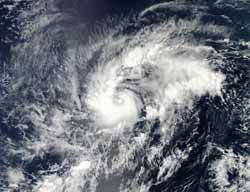NASA Sees Brief Life of Tropical Storm Olivia

On Oct. 6, 2012 at 21:25 UTC 5:25 p.m. EDT, NASA's Aqua satellite captured this true-color image of Tropical Storm Olivia off the western Mexico coast. (Credit: NASA/Goddard/MODIS Rapid Response Team)<br>
On Oct. 6, Tropical depression 15E was born near 14.0 North latitude and 118.7 West longitude, about 845 miles southwest of the southern tip of Baja California. It would later strengthen into Tropical Storm Olivia.
On Oct. 6, 2012, at 21:25 UTC 5:25 p.m. EDT, the Moderate Resolution Imaging Spectroradiometer (MODIS) instrument that flies aboard NASA's Aqua satellite captured a true-color image of Tropical Storm Olivia off the western Mexico coast. Olivia looked promising, with a large band of thunderstorms wrapping into its center of circulation from the north and west, but adverse atmospheric conditions quickly took a toll on the system.
On Oct. 9, 2012, Tropical Storm Olivia ceased to qualify as a tropical cyclone and was designated by the National Hurricane Center as a remnant low pressure area.
At 0900 UTC (5 a.m. EDT), on Oct. 9, Olivia had maximum sustained winds near 35 mph (55 kph). It was centered about 950 miles (1,530 km) west-southwest of the southern tip of Baja California, near 15.2 North and 122.0 West. It was moving to the southwest at 7 mph (11 kph). Olivia's remnants are expected to continue weakening and move southwest then west before dissipating on Wednesday, Oct. 10.
Text credit: Rob Gutro
NASA's Goddard Space Flight Center, Greenbelt, Md.
Media Contact
All latest news from the category: Earth Sciences
Earth Sciences (also referred to as Geosciences), which deals with basic issues surrounding our planet, plays a vital role in the area of energy and raw materials supply.
Earth Sciences comprises subjects such as geology, geography, geological informatics, paleontology, mineralogy, petrography, crystallography, geophysics, geodesy, glaciology, cartography, photogrammetry, meteorology and seismology, early-warning systems, earthquake research and polar research.
Newest articles

Bringing bio-inspired robots to life
Nebraska researcher Eric Markvicka gets NSF CAREER Award to pursue manufacture of novel materials for soft robotics and stretchable electronics. Engineers are increasingly eager to develop robots that mimic the…

Bella moths use poison to attract mates
Scientists are closer to finding out how. Pyrrolizidine alkaloids are as bitter and toxic as they are hard to pronounce. They’re produced by several different types of plants and are…

AI tool creates ‘synthetic’ images of cells
…for enhanced microscopy analysis. Observing individual cells through microscopes can reveal a range of important cell biological phenomena that frequently play a role in human diseases, but the process of…





















